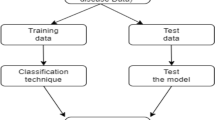Abstract
The coronary heart stroke rates are increasing rapidly in people of all ages and gender. Cardiovascular diseases are posing a crucial and critical challenge and also the inaccurate prediction may lead to fatality. Contemporary prediction techniques like machine learning have been a useful approach in predicting these attacks with the help of the healthcare industry. In this paper, different methods are suggested to find a good-sized feature set by applying various prediction techniques which leads to enhancement of accuracy. The predictive model is delivered with various machine learning strategies.
Access this chapter
Tax calculation will be finalised at checkout
Purchases are for personal use only
Similar content being viewed by others
References
Vaideeswar P, Tyagi S, Singaravel S (2019) Pathology of atherosclerotic coronary artery disease in the young Indian population. Forensic Sci Res 4(3):241–246. https://doi.org/10.1080/20961790.2019.1592315
Priyanka N, Ravikumar P (2017) Usage of data mining techniques in predicting the heart diseases—Naïve Bayes & decision tree. In: Proceedings of IEEE international conference on circuit, power and computing technologies ICCPCT 2017. https://doi.org/10.1109/iccpct.2017.8074215
Aditi Gavhane KD, Kokkula G, Pandya I (2017) Prediction of heart disease using supervised learning algorithms. Int J Comput Appl 165(5):41–44. https://doi.org/10.5120/ijca2017913868
Alaa AM, Bolton T, Di Angelantonio E, Rudd JHF, van der Schaar M (2019) Cardiovascular disease risk prediction using automated machine learning: a prospective study of 423,604 UK Biobank participants. PLoS ONE 14(5):1–17. https://doi.org/10.1371/journal.pone.0213653
Rahul, Bansal H, Monika (2020) Classification techniques used in sentiment analysis & prediction of heart disease using data mining techniques: review, pp 1–6. https://doi.org/10.1109/icict46931.2019.8977707
Mohan S, Thirumalai C, Srivastava G (2019) Effective heart disease prediction using hybrid machine learning techniques. IEEE Access 7:81542–81554. https://doi.org/10.1109/ACCESS.2019.2923707
Subhadra K, Vikas B (2019) Neural network based intelligent system for predicting heart disease. Int J Innov Technol Explor Eng 8(5):484–487
Golande A, Pavan Kumar T (2019) Heart disease prediction using effective machine learning techniques. Int J Recent Technol Eng 8(1) Special Issue 4:944–950
Heart-Health Screenings|American Heart Association. https://www.heart.org/en/health-topics/consumer-healthcare/what-is-cardiovascular-disease/heart-health-screenings
UCI machine learning repository: heart disease data set. http://archive.ics.uci.edu/ml/datasets/Heart+Disease
scikit-learn: machine learning in Python—scikit-learn 0.22.2 documentation. https://scikit-learn.org/stable/
Karaduzovic-Hadziabdic K, Köker R (2015) Diagnosis of heart disease using a committee machine neural network, vol 1, pp 351–360. https://doi.org/10.14794/icai.9.2014.1.351
Vieira S, Pinaya WHL, Mechelli A (2017) Using deep learning to investigate the neuroimaging correlates of psychiatric and neurological disorders: methods and applications. Neurosci Biobehav Rev 74:58–75. https://doi.org/10.1016/j.neubiorev.2017.01.002
Wu P, Zhao H (2011) Some analysis and research of the AdaBoost algorithm. Commun Comput Inf Sci 134(1):3–5. https://doi.org/10.1007/978-3-642-18129-0_1
Ke G et al (2017) LightGBM: a highly efficient gradient boosting decision tree. In: Advances in neural information processing systems, vol 2017-Decem, no. Nips, pp 3147–3155
Gayathri BM, Sumathi CP (2016) An automated technique using Gaussian naive Bayes classifier to classify breast cancer. Int J Comput Appl 148(6):16–21
Author information
Authors and Affiliations
Corresponding author
Editor information
Editors and Affiliations
Rights and permissions
Copyright information
© 2021 The Editor(s) (if applicable) and The Author(s), under exclusive license to Springer Nature Singapore Pte Ltd.
About this paper
Cite this paper
Rahul, Monika, Ray, P., Kharke, R.B., Chauhan, S.S. (2021). Cardiovascular Disease Classification Using Different Algorithms. In: Ranganathan, G., Chen, J., Rocha, Á. (eds) Inventive Communication and Computational Technologies. Lecture Notes in Networks and Systems, vol 145. Springer, Singapore. https://doi.org/10.1007/978-981-15-7345-3_16
Download citation
DOI: https://doi.org/10.1007/978-981-15-7345-3_16
Published:
Publisher Name: Springer, Singapore
Print ISBN: 978-981-15-7344-6
Online ISBN: 978-981-15-7345-3
eBook Packages: EngineeringEngineering (R0)




